Windows Defender, which prevents malicious viruses and programs from attacking your computer, is one of the most significant built-in features of Windows. However, what happens if Windows Defender abruptly stops functioning or reacting? Due to this issue, many Windows users have trouble updating, changing or activating Windows Defender Firewall settings. This post will share suggestions to help you if you are unable to change Windows Firewall settings in Windows 11/10.
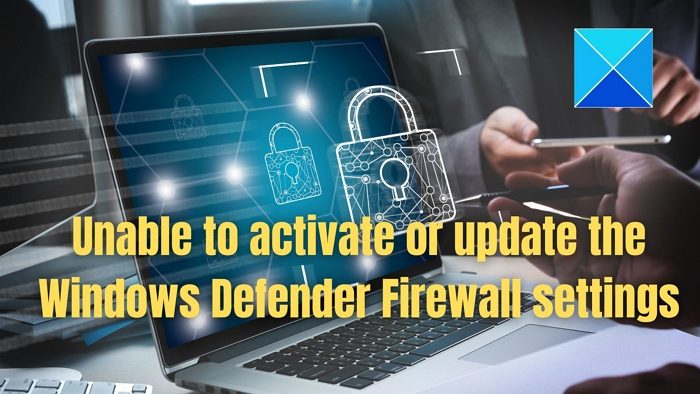
Unable to change Windows Firewall settings
We have curated working methods that will help you update or change the Firewall settings in Windows 11/10:
- Disable third-party Anti-virus software
- Reset Windows firewall settings
- Change the DisableAntiSpyware value in the registry entry
- Check firewall services
You will need admin permission to execute these suggestions.
1] Disable third-party Anti-virus software
If your computer has any third-party security software installed, there is an increased possibility that it is interfering with Windows Firewall and preventing it from functioning. Therefore, if you recently installed another antivirus software, we advise turning off or uninstalling the third-party security software and turning on Windows Firewall instead.
Depending on the installed program, different steps may be involved in disabling third-party antivirus software. You can either uninstall the app or follow the steps given below to disable the third-party anti-virus software:
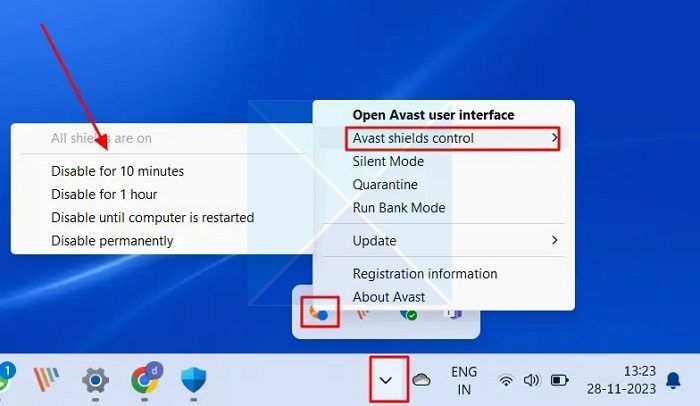
- Expand the Show hidden icons icon on the taskbar, and right-click the antivirus icon.
- Click the anti-virus’s shield control option.
- You should be able to temporarily disable the antivirus software by selecting the preferred option from the context menu until you restart your computer.
Try turning on the Windows Firewall after turning off the antivirus software to see if it now operates correctly.
2] Reset Windows firewall settings
There’s a chance that the Firewall settings could cause the issue. Resetting Windows Firewall settings will resolve such problems by returning the firewall configuration to its original state and removing any customizations or changes that may be the source of conflicts.
Reset using Windows Security:
- Type Windows Security into the Windows search bar and click the result.
- In the Windows Security window, click Firewall & network protection on the left pane.
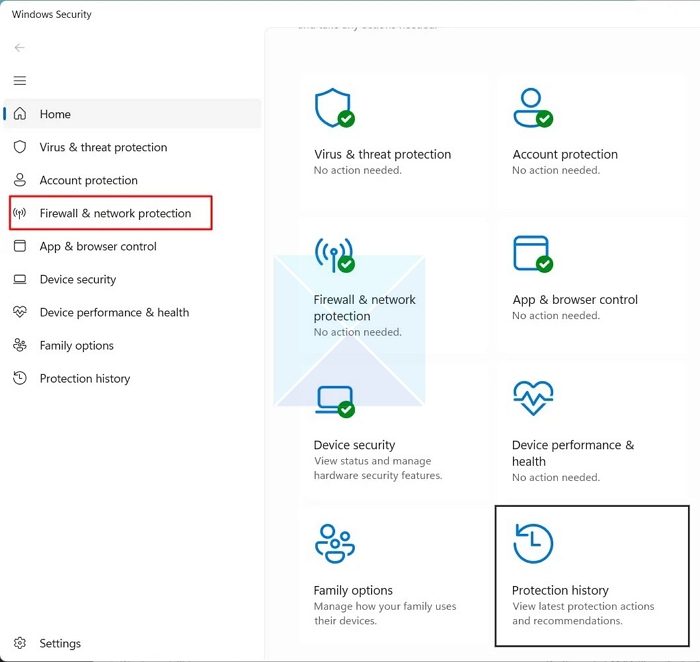
- Click Restore firewalls to defaults at the bottom of the window.
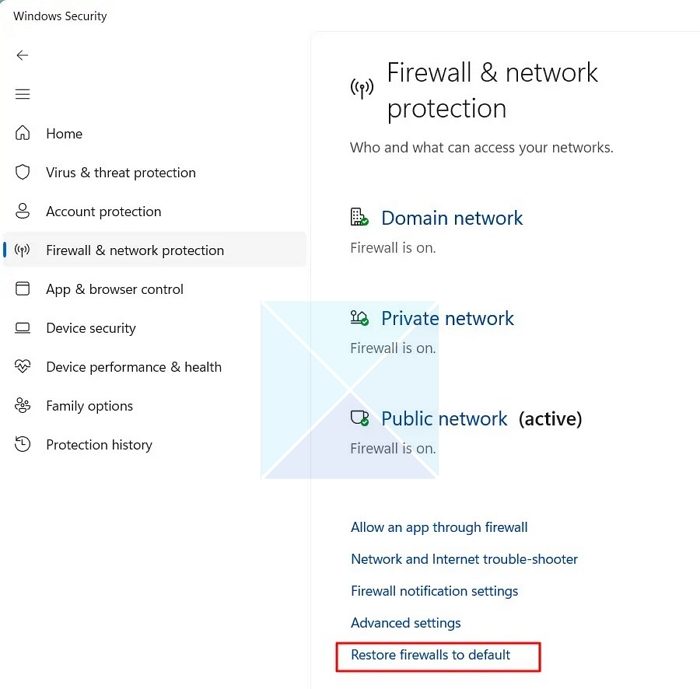
- Click the Restore defaults button and click Yes when prompted to start resetting Windows Firewall settings.
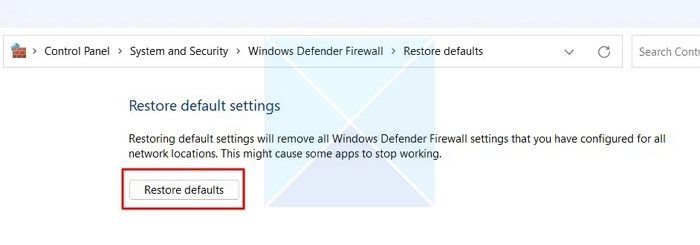
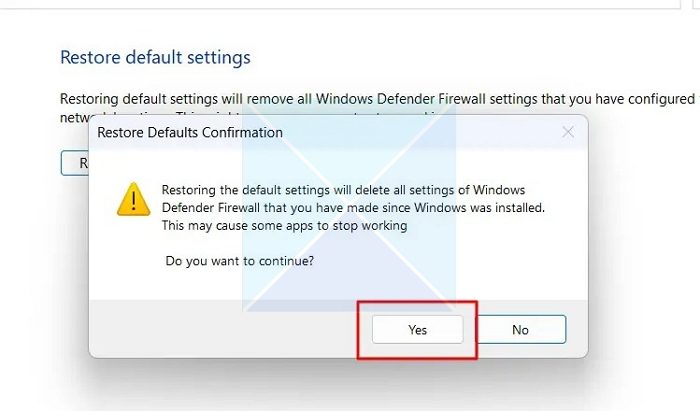
Reset using Windows Terminal
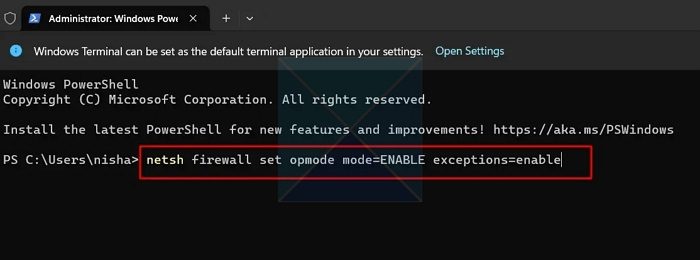
- Open Terminal (Admin), type the following command, and press Enter to run it.
netsh firewall set opmode mode=ENABLE exceptions=enable
- The firewall components will be forcefully enabled when the command has finished running.
- Wait and restart your computer and verify whether the issue is resolved.
3] Change the DisableAntiSpyware value in the registry entry
It is also possible that you cannot enable the Firewall on your computer because a Registry key called DisableAntiSpyware is active. You can use the Registry Editor to see if this applies to your situation by checking the DisableAntiSpyware key’s status.
But to be sure, we strongly advise making a Registry backup before moving forward. After you complete the backup, follow the steps given below:
- Open Registry Editor and navigate to the path given below:
HKEY_LOCAL_MACHINE\SOFTWARE\Policies\Microsoft\Windows Defender
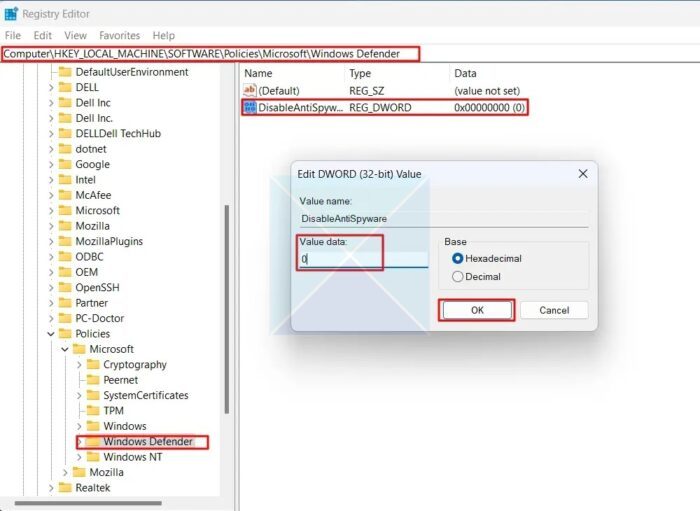
- On the right, check for the DisableAntiSpyware key. Once you have found it, delete it. If you do not want to delete it, double-click on it to set its Value data to 0 and click OK to save the changes.
- Once you are done, navigate to the following path:
HKEY_LOCAL_MACHINE/SYSTEM/CurrentControlSet/Services/BFE
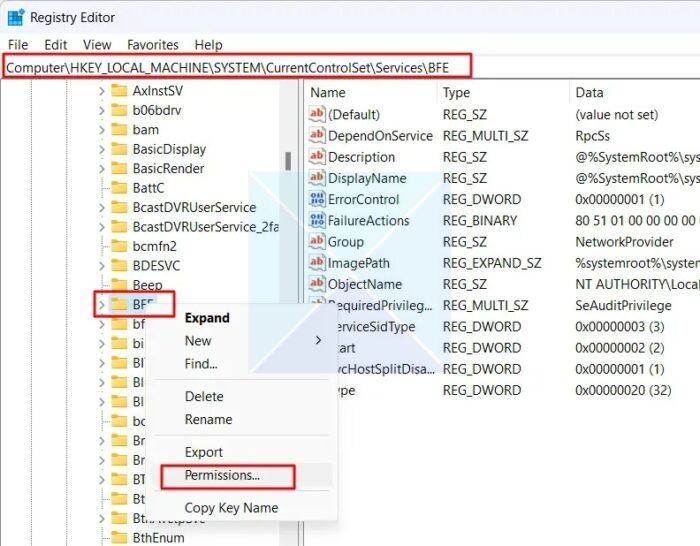
- Right-click the BFE key and choose Permissions from the context menu.
- Click the Add button under Groups or user names in the Permissions for BFE pop-up window.
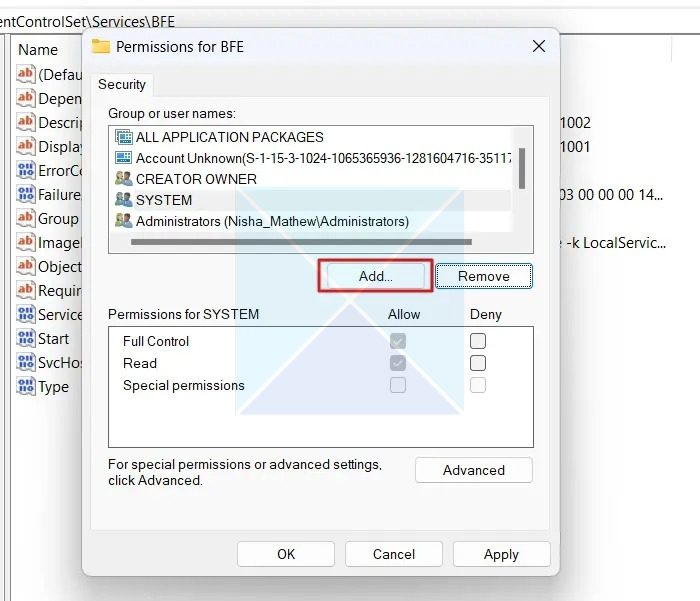
- In the Select Users or Groups pop-up window, type Everyone under Enter the object names to select and press OK.
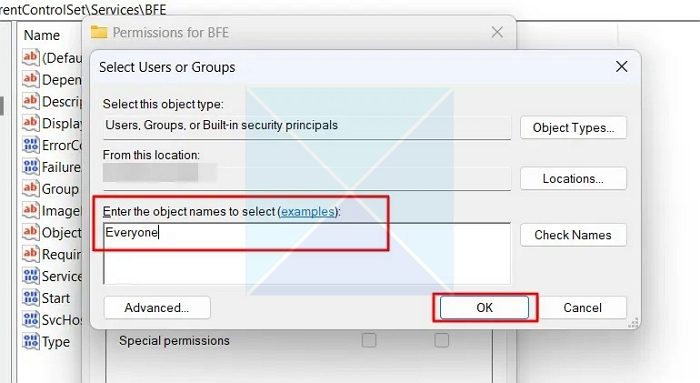
- Under Permissions for Everyone, click the checkbox next to Full Control, press Apply, then OK to save the changes, and check whether the issue is resolved.
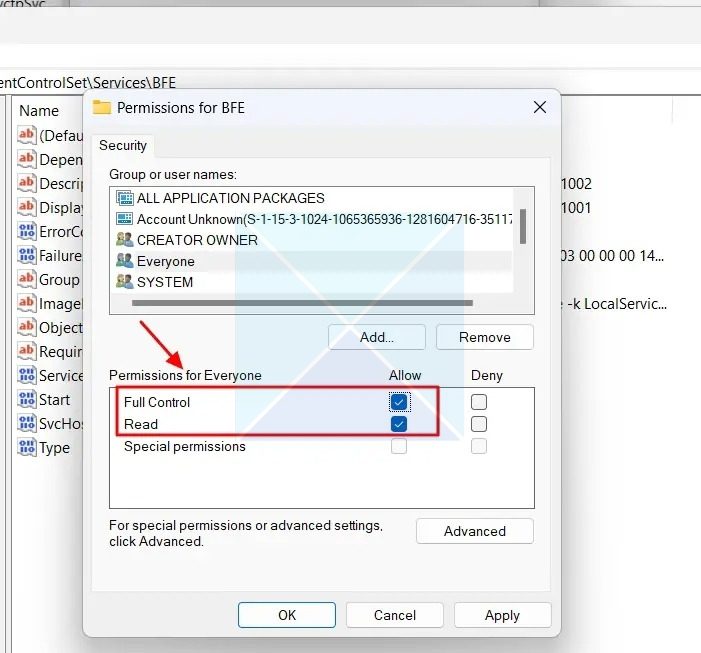
4] Make sure Firewall related Services are working
If you cannot activate the firewall after using the methods given above, ensure the Windows Defender Firewall service and any associated services are operating correctly. Follow the steps given below to check whether the firewall-related services are enabled:
- Type Services into the Windows search bar and click the result to open the Windows Services app.
- In the Services app window, scroll down, locate, and double-click Windows Defender Firewall from the list.
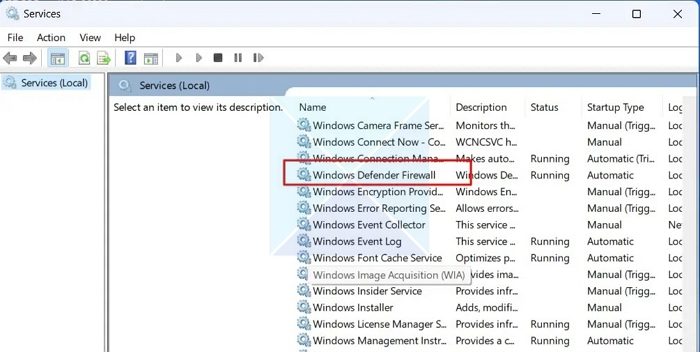
- In the Windows Defender Firewall Properties (Local Computer) window, click the General tab and check whether the Service status is shown as Running.
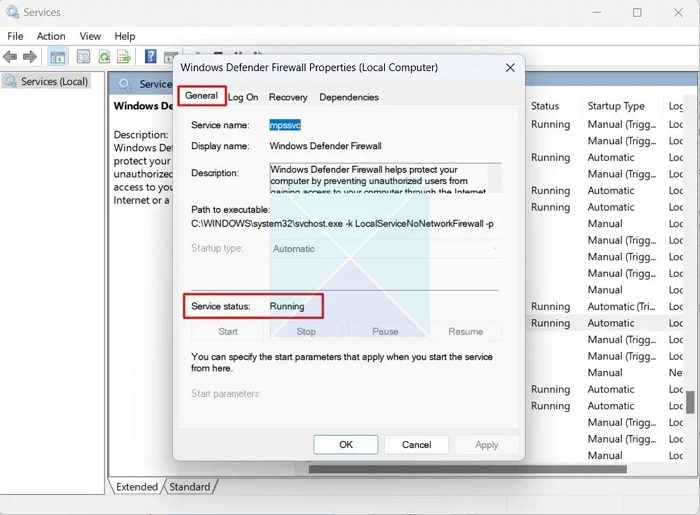
- If it is not enabled, click the Start button below the Service status to enable the Windows Defender Firewall service and check if the issue is resolved.
Read: Windows Firewall Service does not start
Conclusion
You should have no trouble troubleshooting Windows Firewall problems by following the methods mentioned in the article. If the error continues and you are hesitant to perform a clean install of the system, you can file a support ticket with Microsoft and track down a potential solution.
Related: Windows Firewall can’t change some of your settings: 0x8007042c, 0x80070422, 1068, 0x8007045b, 0x800706d9, 0x80070437
Should you allow Windows Defender Firewall?
It is crucial to have Microsoft Defender Firewall enabled, even if you already have another firewall installed on your device. The reason is that it helps safeguard your system from unauthorized access. You need to choose a network profile that suits your needs- Domain network, Private network, or Public network- and then turn on the Microsoft Defender Firewall setting to ensure that it is active.
Read: Windows could not start the Windows Firewall on Local Computer
How safe is Windows Firewall?
It uses IPsec to make sure that only authorized devices can connect to the network and that all traffic is encrypted. Windows Defender Firewall is a simple solution that helps keep your data safe from cyber threats without needing extra hardware or software.
Leave a Reply